Innovation in Energy Saving: Application for the Optimization of Consumption and the Integration of Photovoltaic Energy
Abstract
1. Introduction
2. Energy Consumption
3. Operation of the Electricity Market
- Wholesale market: in this market, electricity generators such as nuclear, solar, wind and gas plants sell electricity to retailers, large consumers or directly to the grid. The wholesale market is organized into different temporary markets:
- –
- Day-ahead market: here participants bid and offer to buy and sell electricity for the next day. Prices are determined based on an auction mechanism, where the cross between supply and demand establishes the marginal price, as shown in Figure 2. This price is applied uniformly to all transactions in that interval.
- –
- Intraday market: adjusts daily market forecasts by allowing participants to modify their bids according to changes in production or demand.
- –
- Adjustment market: ensures that supply and demand are balanced in real time.
- Retail market: here electricity is sold by retailers to final consumers (households, businesses and industry). Prices in the retail market are influenced by wholesale market costs, network tariffs, taxes and other factors.
4. Renewable Energies
5. Current Tariff Situation
- Spain:
- Indexed prices: prices vary according to the wholesale market, allowing consumers to take advantage of times of low demand to pay less, but exposing them to higher prices at times of high demand.
- PVPC tariff (Voluntary Price for Small Consumers): the price varies every hour according to the wholesale market, regulated by the government.
- Germany:
- Fixed vs. variable tariffs: electricity tariffs in Germany are highly influenced by environmental taxes and the cost of renewable energies. Consumers can choose between tariffs with long-term fixed prices or variable tariffs that fluctuate according to the market.
- EEG-Umlage: this is a specific surcharge to finance renewables, which is added to the basic cost of electricity.
- France:
- Regulated Blue Tariff (TRV): this is a fixed tariff regulated by the government, available to households and small businesses, which guarantees some stability against market fluctuations.
- Green tariff options: some suppliers offer renewable energy tariffs that guarantee that the electricity supply comes from sources such as wind or solar.
- Portugal:
- Social Electricity Tariff: similar to Spain, Portugal offers subsidized tariffs for vulnerable consumers, with a discount on the bill for low-income households.
- Hourly tariffs: these are structured according to the hours of the day, similar to Spain’s time discriminatory tariffs, with three periods: peak, flat and off-peak.
6. Importance of Photovoltaic Installation Calculations and Solar Radiation Prediction
7. Consumption–Production Cassation
- The electrical grid, managed at the European level by the entities such as ENTSO-E (European Network of Transmission System Operators for Electricity), plays a key role in distributing electricity from generation plants, both renewable and non-renewable, to end consumers. These networks ensure supply while allowing for the integration of renewable sources such as solar and wind.
- Self-generation: this type of generation allows consumers to self-consume using renewable sources, such as photovoltaic panels or modules, enabling them to save not only on their electricity bills but also on overall electricity consumption. To meet the demand for electrical energy, various sources are used, both renewable (solar, wind, hydroelectric, and biomass) and non-renewables. Photovoltaic solar energy has gained importance due to its ability to enable self-consumption, generate surpluses, or reduce grid consumption, thanks to the generation from solar panels that convert sunlight into electricity.
- Self-consumption refers to a consumer’s ability to generate and consume their own energy. This reduces reliance on the electrical grid and can result in savings on the electricity bill. Self-consumption lowers costs by decreasing energy consumption from the grid and reducing electricity bills, generates less dependence on the electrical network, and contributes to the reduction in greenhouse gas emissions.
- Surplus refers to the energy generated that is not consumed and can be fed back into the electrical grid. This energy can be sold to the utility company, providing compensation for the surplus.
- Grid consumption is the energy that a consumer obtains from the electrical grid when their self-generation is insufficient to meet their demand. To feed energy back into the grid, it is important to consider that the grid must balance supply and demand, efficiently integrating renewable generation.
8. Developed Tool
- Data entry: This section, of which a screenshot is shown in Figure 8 and Figure 9, is the starting point from which all the information required for the analysis is collected. Here, the user is asked to enter the customer’s personal data, such as name, address and contact details. In addition, data specific to the installation under study is collected, which could include information on the location of the installation, the type of building (residential, commercial, industrial), the contracted power, the type of tariff, whether they had a social bonus, a photovoltaic installation, and other relevant details. These data provide the necessary context for an accurate analysis of the customer’s electricity situation.
- Consumption: In this section, electricity consumption data are collected, as can be seen in Figure 10. The user must enter detailed information on monthly or annual consumption, specifying the consumptions obtained from his distributor. This allows for a detailed analysis of electricity consumption patterns over time. In addition, the tariff period to which each meter reading belongs can be considered, which is crucial to accurately calculate the costs associated with electricity consumption. In addition, a summary is made that shows in which months and on which days, working days or holidays, consumption is higher in percentage terms.
- Generation: In this part, shown in Figure 11, the user is asked to enter the desired peak power for the PV installation, which allows the estimated hourly production of solar energy to be calculated. In addition, the self-consumption of solar energy, the surplus of generated energy that is fed into the grid and the consumption of energy from the grid when the solar generation is not sufficient to meet the demand are calculated. These calculations, which take into account tilt, orientation, latitude and longitude, are performed using Visual Basic, which ensures the accuracy of the calculations.
- Tariff comparator: This section provides the user with a tool to compare the tariffs offered by different electricity companies. The cost of each tariff is calculated based on the consumption entered and the tariffs are ordered from lowest to highest cost, as shown in Figure 12 and Figure 13. This allows the user to make informed decisions on the selection of the most suitable electricity tariff for their needs and budget.
- Output: In this section, the results of the analysis are presented in the form of a report on the different scenarios considered. Figure 14 and Figure 15 show the layout and design of this section. A clear and concise summary of the initial situation (E0) is provided, as well as the alternative situations that arise when applying changes in the electricity tariff (E1) and when considering the installation of solar PV panels (E2). Furthermore, the possibility to explore additional scenarios (E3) combining different energy consumption and production profiles can be included, providing a more complete and detailed view of the options available to the customer.
8.1. Profile Simulation
- Value 0: actual consumption, obtained from the distribution company.
- Value 1: average consumption.
- Value 2: percentage consumption. The term refers to the distribution of consumption in different percentages during the day and night. For example, in the case, 80-20 consumption, what is indicated is that 80% of the consumption takes place during daytime hours, while the remaining 20% occurs during nighttime hours.
- Value 3: BOE Profile. The BOE electricity consumption profile estimates consumers’ hourly electricity uses without requiring precise hourly metering, resulting in a fair allocation of costs and billing. The CNMC determines the profile by considering factors such as type of consumer, season, day of the week and daytime hours. It uses hourly weighting coefficients for different periods and types of days, simplifying the billing and electricity consumption management process. The BOE, which is published annually, contains the up-to-date and detailed information necessary for accurate billing and energy allocation.
- Value 0: actual generation, based on irradiance data obtained from PVGIS.
- Value 1: average annual generation in sunshine hours.
- Value 2: average monthly generation in hours of sunshine.
- Value 3: generation of a typical year.
8.2. Real Case Study
- From your distributor’s website:
- Identify your distributor: on the bill, look for the CUPS (Universal Supply Point Code). The CUPS usually starts with ES0021, ES0031, ES0022, etc., which indicates the distributor:
- Access your distributor’s virtual office:
- -
- Register or log in.
- -
- Look for the section “My consumption”/“Consumption data”.
- -
- Download the data in Excel (CSV) with hourly details.
- From your supplierSome suppliers (Endesa, Iberdrola, Naturgy, etc.) also allow you to view and download your consumption:
- Access their website or app.
- Look for the consumption/billing section.
- Download the report in PDF or Excel.
- Profile 0: Actual generation based on irradiance data obtained from PVGIS.
- Profile 1: Average annual generation in sunshine hours.
- Profile 2: Average monthly generation in hours of sunshine.
- Profile 3: Typical annual generation.
9. Conclusions
Author Contributions
Funding
Institutional Review Board Statement
Informed Consent Statement
Data Availability Statement
Conflicts of Interest
References
- Rosales-Asensio, E.; Diez, D.B.; Cabrera, P.; Sarmento, P. Effectiveness and Efficiency of Support Schemes in Promoting Renewable Energy Sources in the Spanish Electricity Market. Int. J. Electr. Power Energy Syst. 2024, 158, 109926. [Google Scholar] [CrossRef]
- Instituto para la Transición Justa, O.A. Strategic Energy and Climate Framework; Instituto para la Transición Justa, O.A.: Madrid, Spain, 2020. [Google Scholar]
- REE Evolución de La Demanda. Información Elaborada Con Datos Provisionales a Enero Del. 2024. Available online: https://www.sistemaelectrico-ree.es/informe-del-sistema-electrico/demanda/evolucion-demanda (accessed on 19 July 2024).
- Saez, R.; Boer, D.; Shobo, A.B.; Vallès, M. Techno-Economic Analysis of Residential Rooftop Photovoltaics in Spain. Renew. Sustain. Energy Rev. 2023, 188, 113788. [Google Scholar] [CrossRef]
- Parreño-Rodriguez, A.; Ramallo-González, A.P.; Chinchilla-Sánchez, M.; Molina-García, A. Community Energy Solutions for Addressing Energy Poverty: A Local Case Study in Spain. Energy Build. 2023, 296, 113418. [Google Scholar] [CrossRef]
- Segura, E.; Belmonte, L.M.; Morales, R.; Somolinos, J.A. A Strategic Analysis of Photovoltaic Energy Projects: The Case Study of Spain. Sustainability 2023, 15, 12316. [Google Scholar] [CrossRef]
- Fernández-González, R.; Suárez-García, A.; Álvarez Feijoo, M.Á.; Arce, E.; Díez-Mediavilla, M. Spanish Photovoltaic Solar Energy: Institutional Change, Financial Effects, and the Business Sector. Sustainability 2020, 12, 1892. [Google Scholar] [CrossRef]
- Secretaría General del Consejo Pacto Verde Europeo. Available online: https://www.consilium.europa.eu/es/policies/green-deal/ (accessed on 14 October 2024).
- IEA. World Energy Outlook 2022; IEA: Paris, France, 2022. [Google Scholar]
- Red Eléctrica Las Renovables Baten Récord y Generan Más de La Mitad de Toda La Electricidad En España En. 2023. Available online: https://www.ree.es/es/sala-de-prensa/actualidad/nota-de-prensa/2023/12/las-renovables-baten-record-y-generan-mas-de-la-mitad-de-toda-electricidad-espana-en-2023 (accessed on 14 October 2024).
- Carmen Goizueta De Mercados Mayoristas y Sanciones Por Infracciones. Available online: https://blog.cnmc.es/2019/08/28/de-mercados-mayoristas-y-sanciones-por-infracciones/ (accessed on 27 June 2024).
- Auer, H.; Haas, R. On Integrating Large Shares of Variable Renewables into the Electricity System. Energy 2016, 115, 1592–1601. [Google Scholar] [CrossRef]
- Meeus, L.; Belmans, R. Electricity Market Integration in Europe; University of Leuven: Leuven, Belgium, 2008. [Google Scholar]
- Vázquez, C.; Rivier, M.; Pérez-Arriaga, I.J. A Market Approach to Long-Term Security of Supply. IEEE Trans. Power Syst. 2002, 17, 349–357. [Google Scholar] [CrossRef]
- Brown, S.; Jones, D.; Fulghum, N.; Bruce-Lockhart, C.; Candlin, A.; Ewen, M.; Czyżak, P.; Rangelova, K.; Heberer, L.; Rosslowe, C.; et al. European Electricity Review. 2024. Available online: https://ember-energy.org/app/uploads/2024/10/European-Electricity-Review-2024.pdf (accessed on 4 January 2025).
- International Renewable Energy Agency. Renewable Energy Statistics 2023; International Renewable Energy Agency: Masdar City, United Arab Emirates, 2023; ISBN 978-92-9260-537-7. Available online: https://www.irena.org/Publications/2023/Jul/Renewable-energy-statistics-2023 (accessed on 4 January 2025).
- Halkos, G.E.; Tsirivis, A.S. Electricity Prices in the European Union Region: The Role of Renewable Energy Sources, Key Economic Factors and Market Liberalization. Energies 2023, 16, 2540. [Google Scholar] [CrossRef]
- CNMC. La Nueva Factura de La Luz. Available online: https://www.cnmc.es/la-nueva-factura-de-la-luz (accessed on 21 June 2024).
- Gabriela Luque, A.; Joseline Aguilera, C.; Lata-García, J.; Onofre, K.V. Analysis of the Performance of Photovoltaic System Through Different Angles of Tilt and Orientation in Equatorial Latitude. In Proceedings of the International Conference on Electrical, Computer and Energy Technologies, ICECET 2023, Cape Town, South Africa, 16–17 November 2023; Institute of Electrical and Electronics Engineers Inc.: New York, NY, USA, 2023. [Google Scholar]
- Hasan, M.; Serra Altinoluk, H. Current and Future Prospective for Battery Controllers of Solar PV Integrated Battery Energy Storage Systems. Front. Energy Res. 2023, 11, 1139255. [Google Scholar] [CrossRef]
- IDAE. Instituto para la Diversificación y Ahorro de la Energía ¿Qué Es El Autoconsumo? Available online: https://www.idae.es/tecnologias/energias-renovables/oficina-de-autoconsumo/que-es-el-autoconsumo (accessed on 28 May 2024).
- Vanya Ignatova Four Strategies for Sizing Your Photovoltaic System. Available online: https://blog.se.com/infrastructure-and-grid/power-management-metering-monitoring-power-quality/2020/02/04/four-strategies-for-sizing-your-photovoltaic-system/ (accessed on 5 November 2024).
- Deguenon, L.; Yamegueu, D.; Moussa Kadri, S.; Gomna, A. Overcoming the Challenges of Integrating Variable Renewable Energy to the Grid: A Comprehensive Review of Electrochemical Battery Storage Systems. J. Power Sources 2023, 580, 233343. [Google Scholar]
- Celia Tena Pintado. Consumos año 2024. Available online: https://docs.google.com/spreadsheets/d/1KsjDMDwN1Xhc-xQJR5fExQKFRuxNWnBX/edit?usp=sharing&ouid=114640214704945989787&rtpof=true&sd=true (accessed on 11 March 2025).
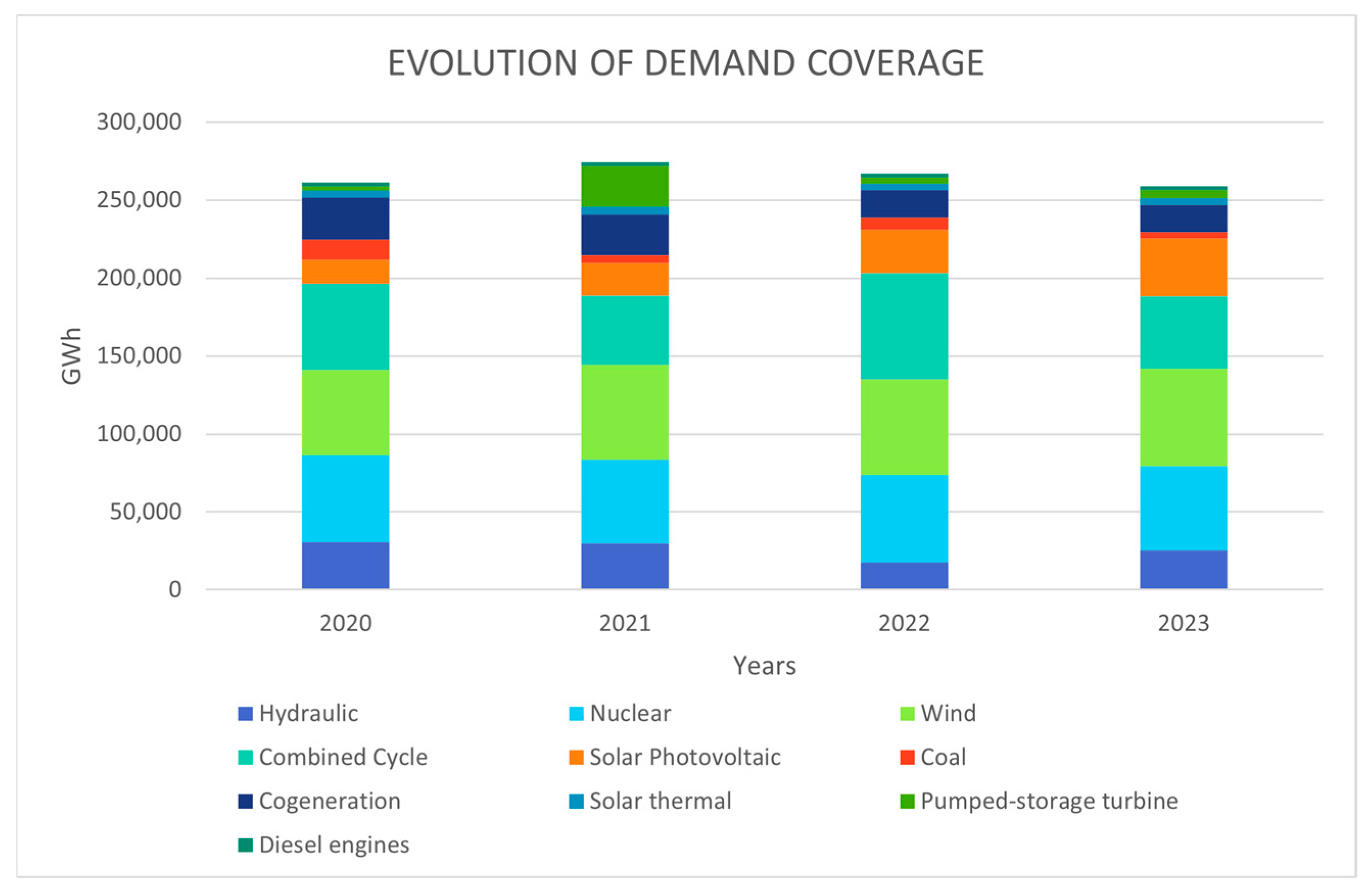

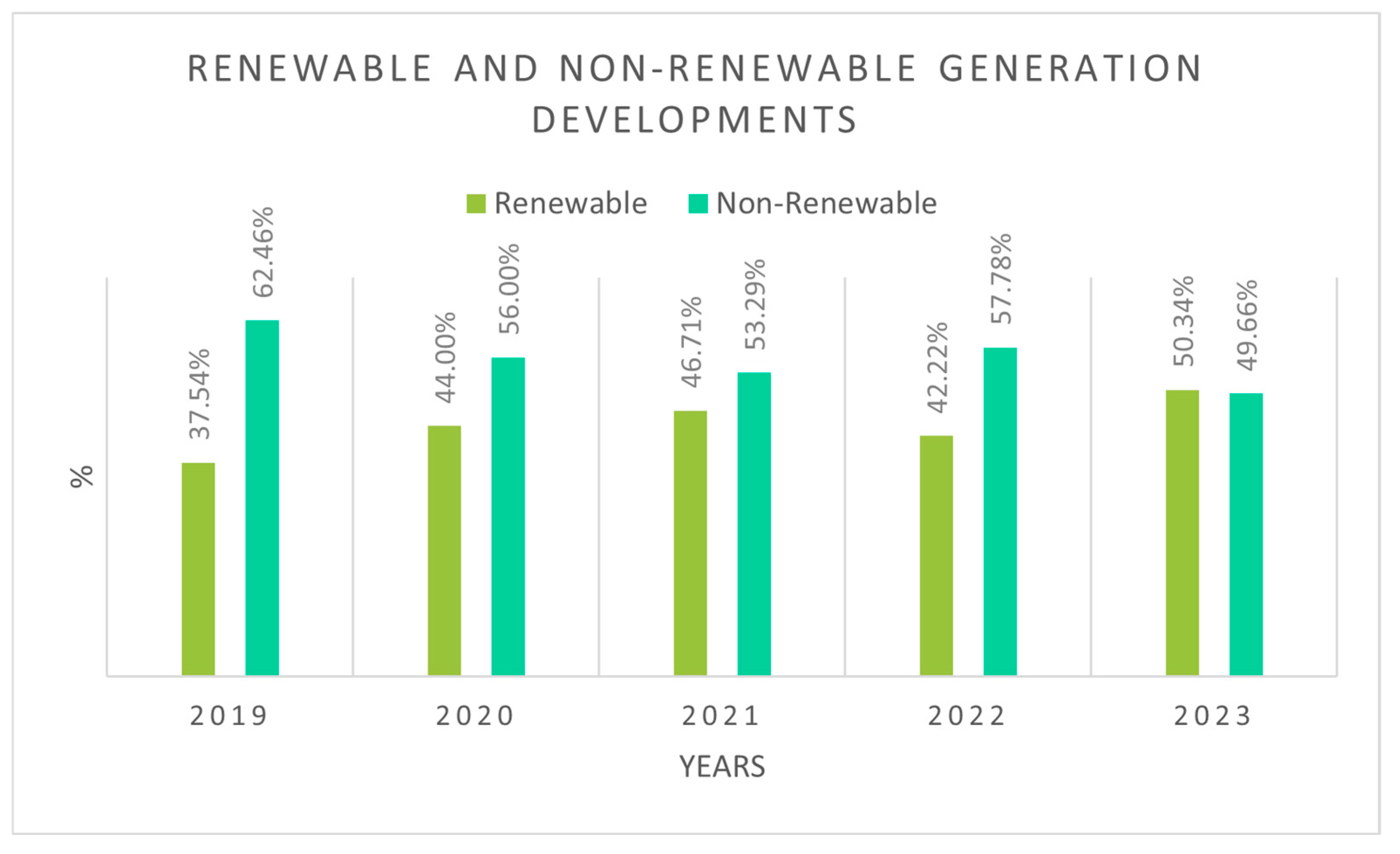
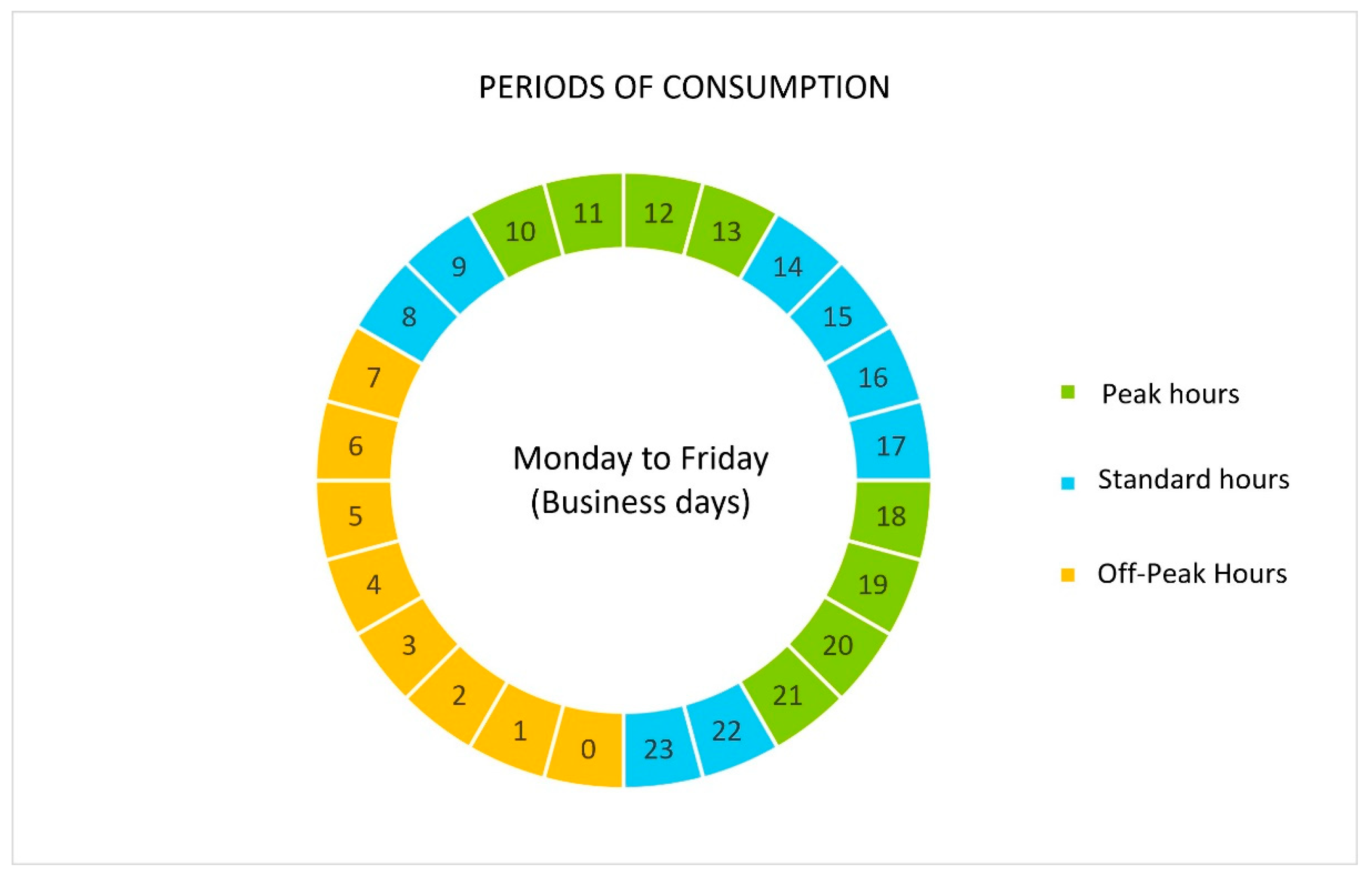
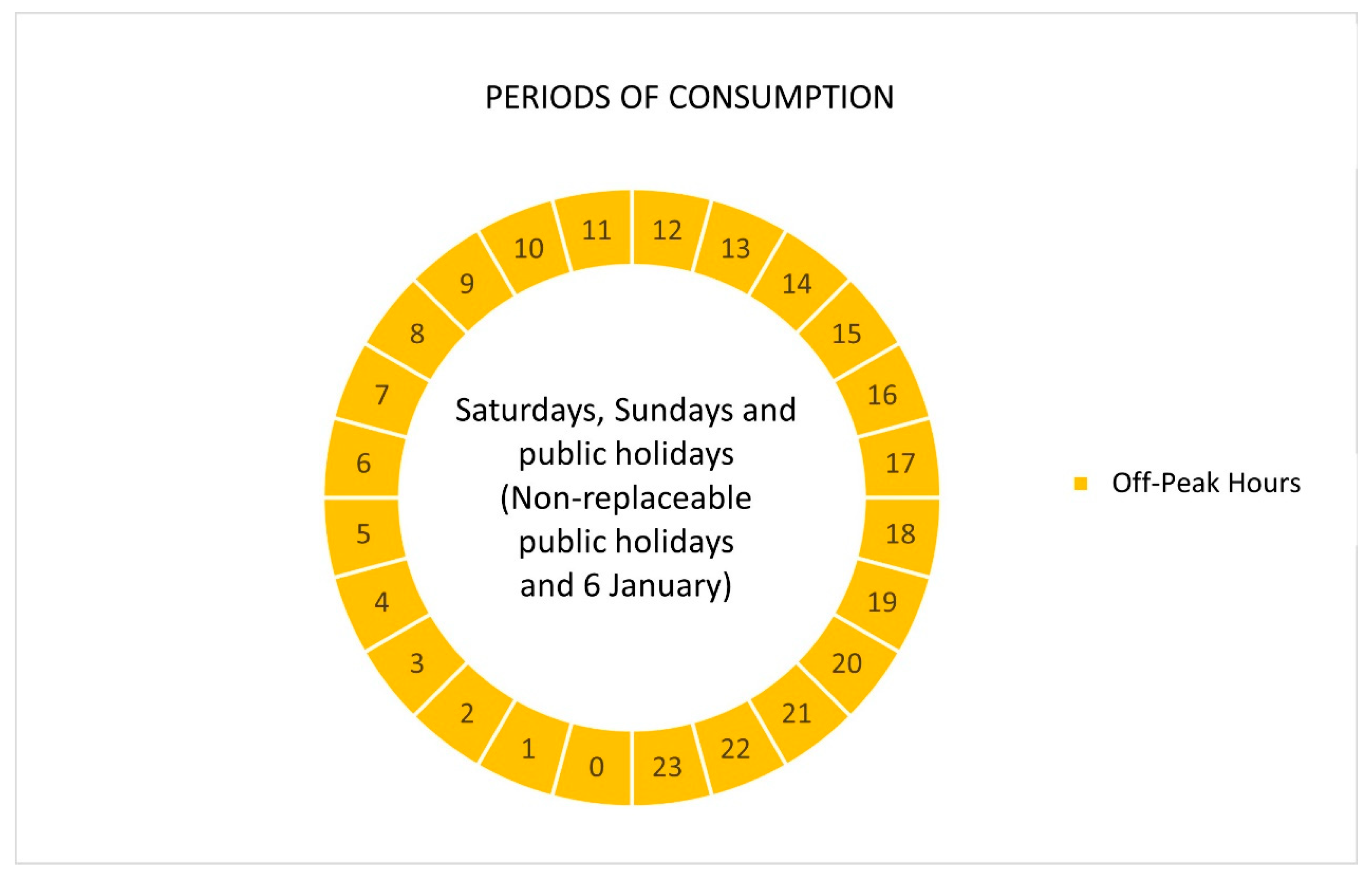
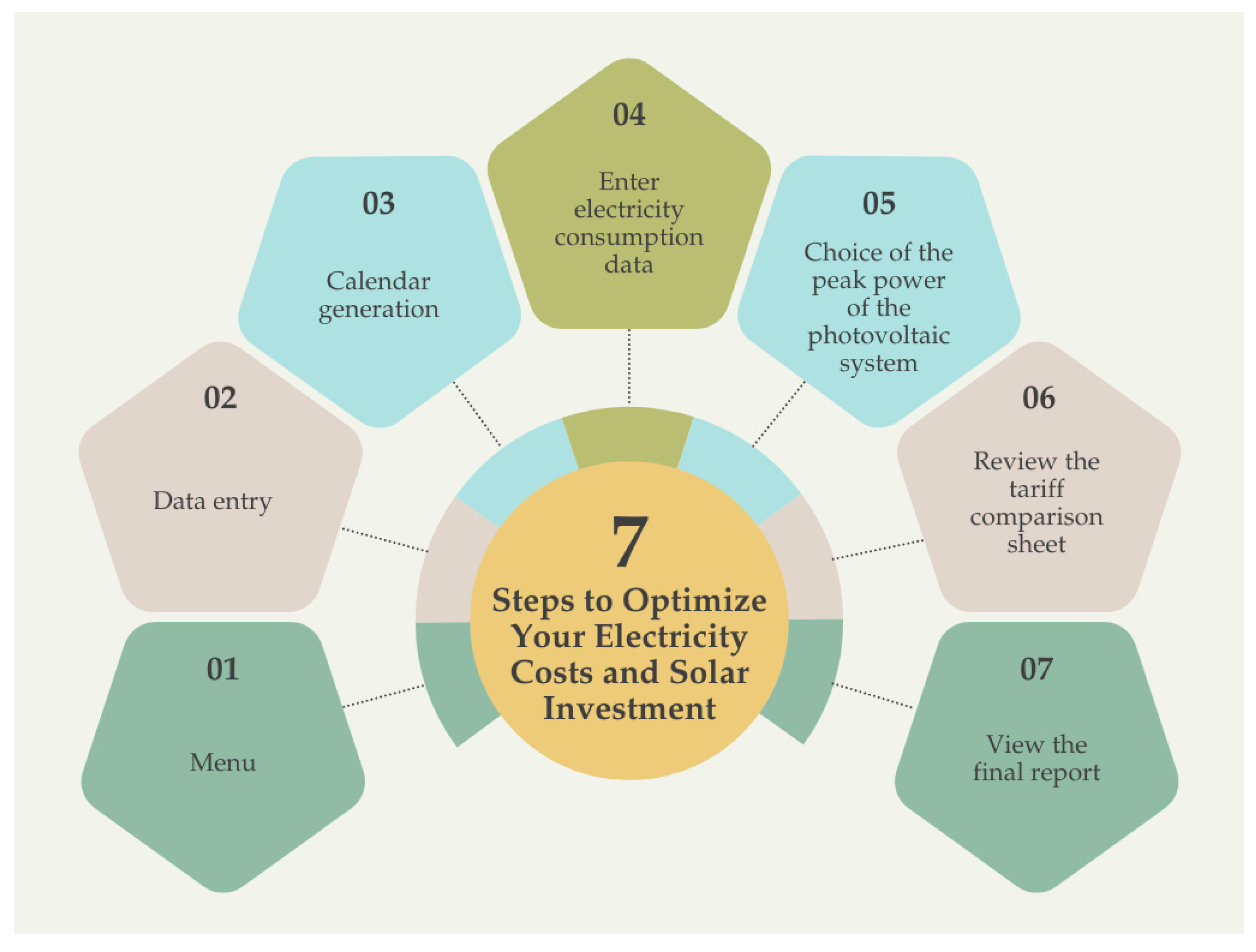

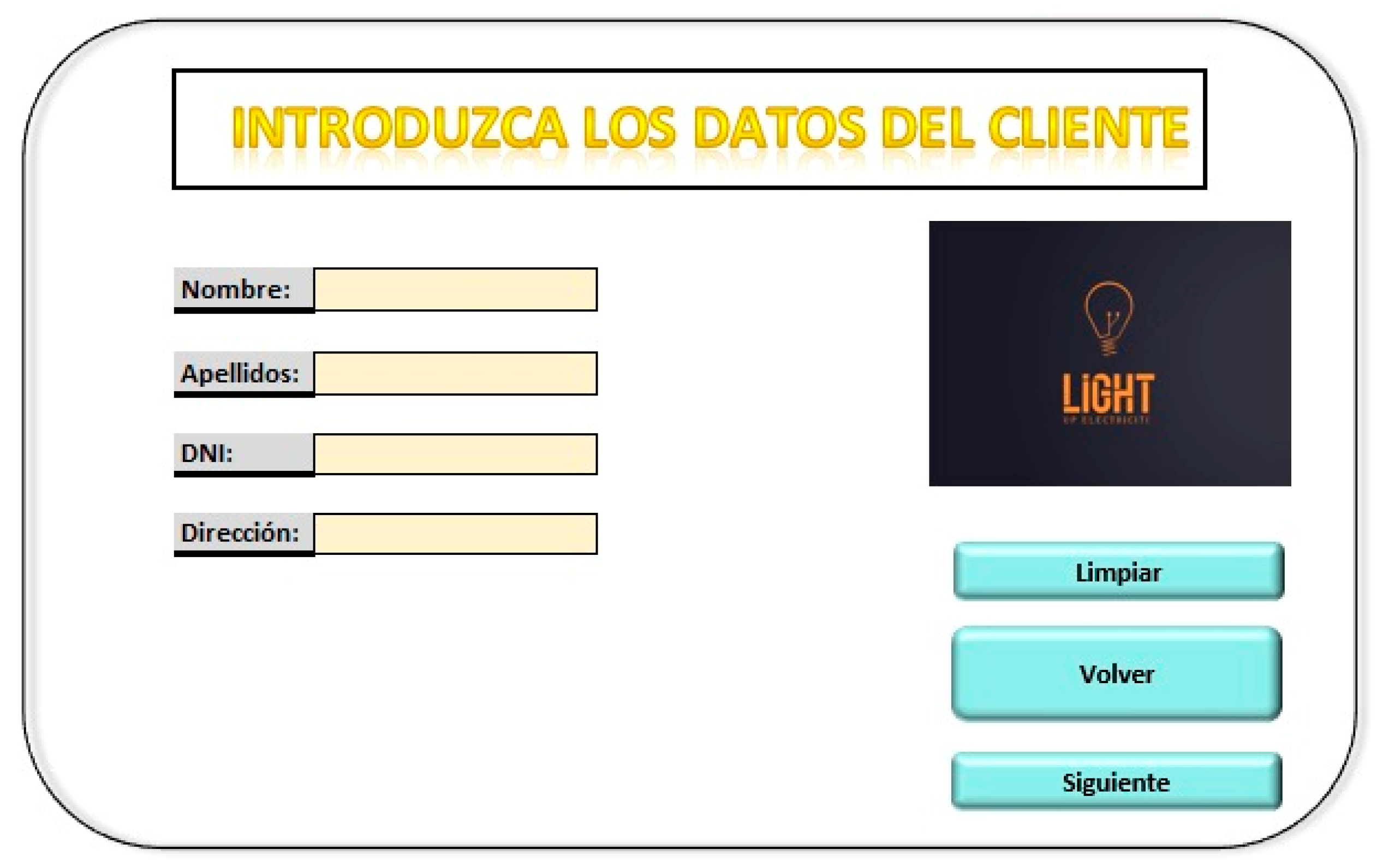
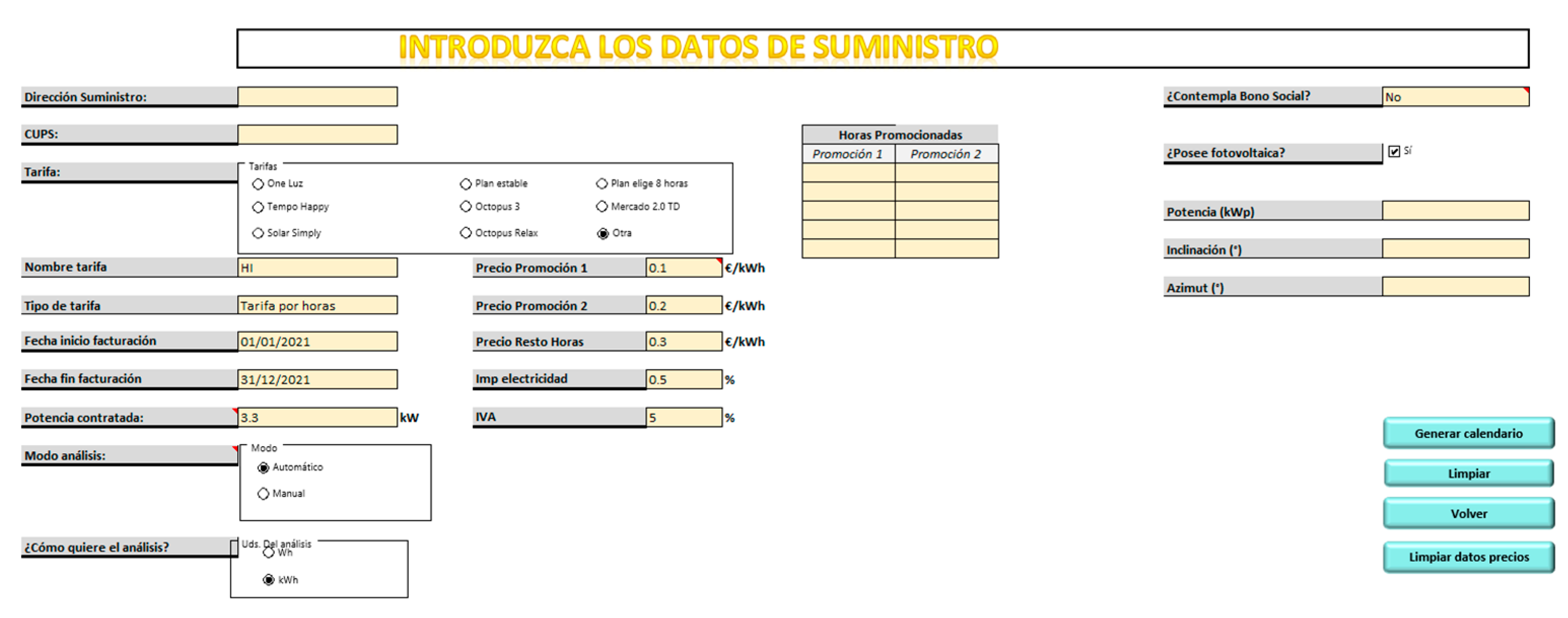
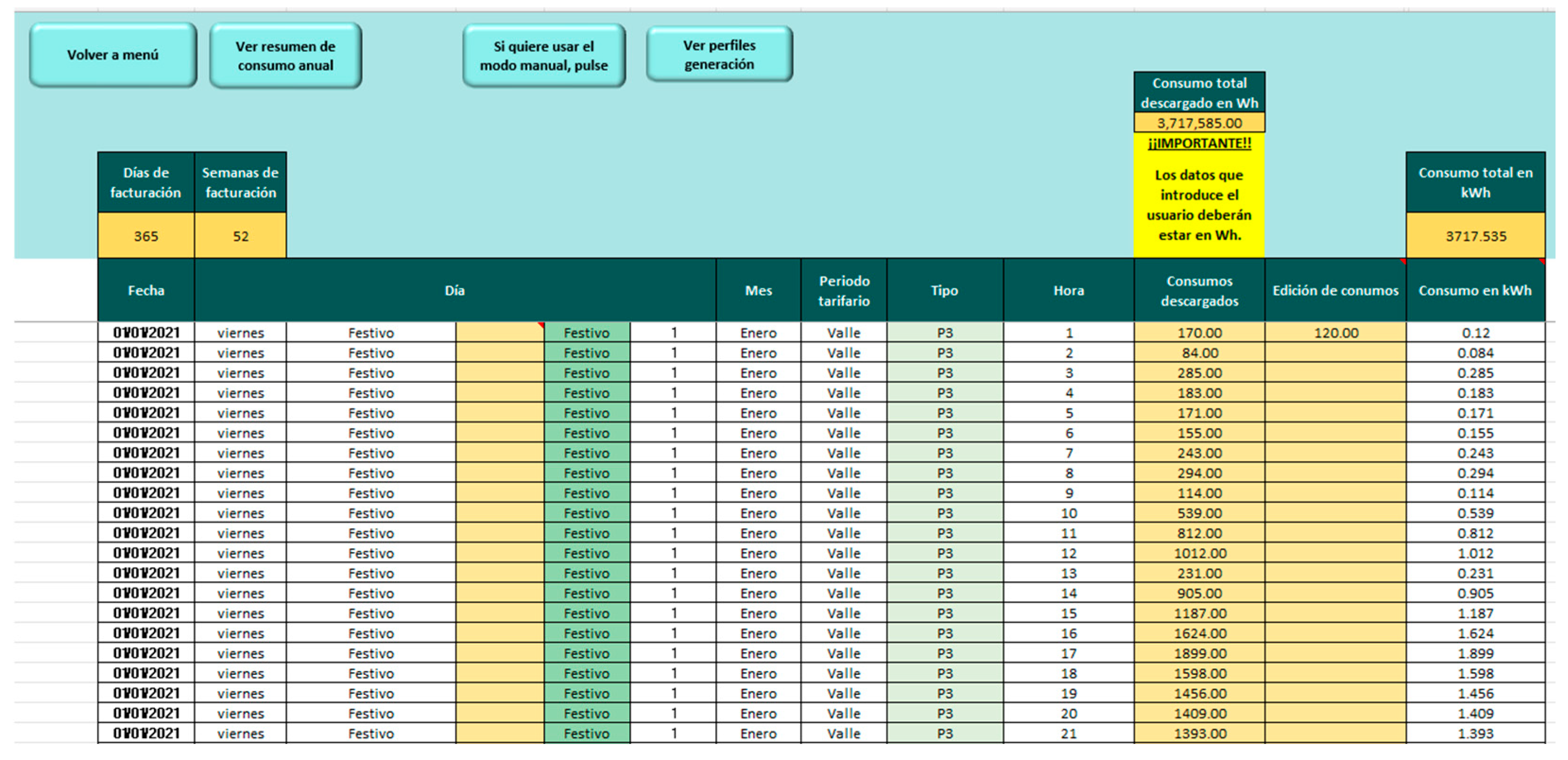
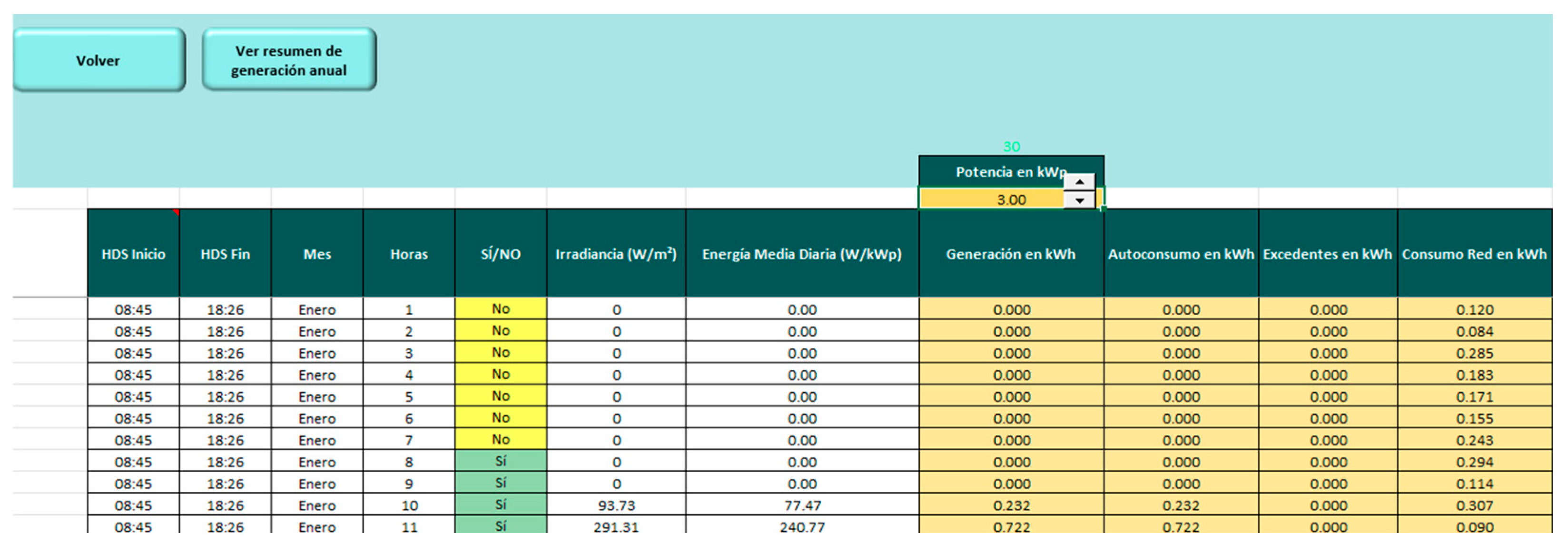

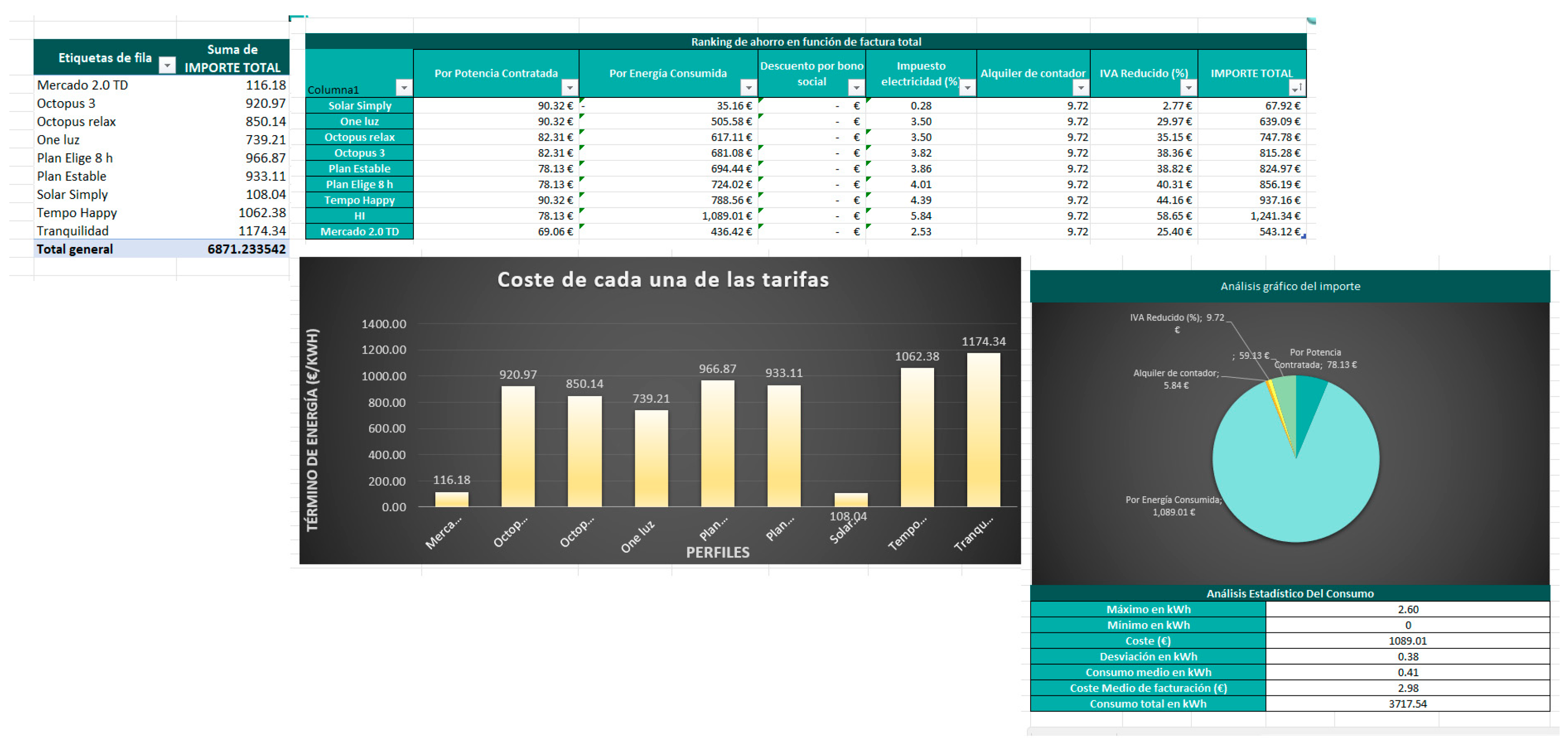

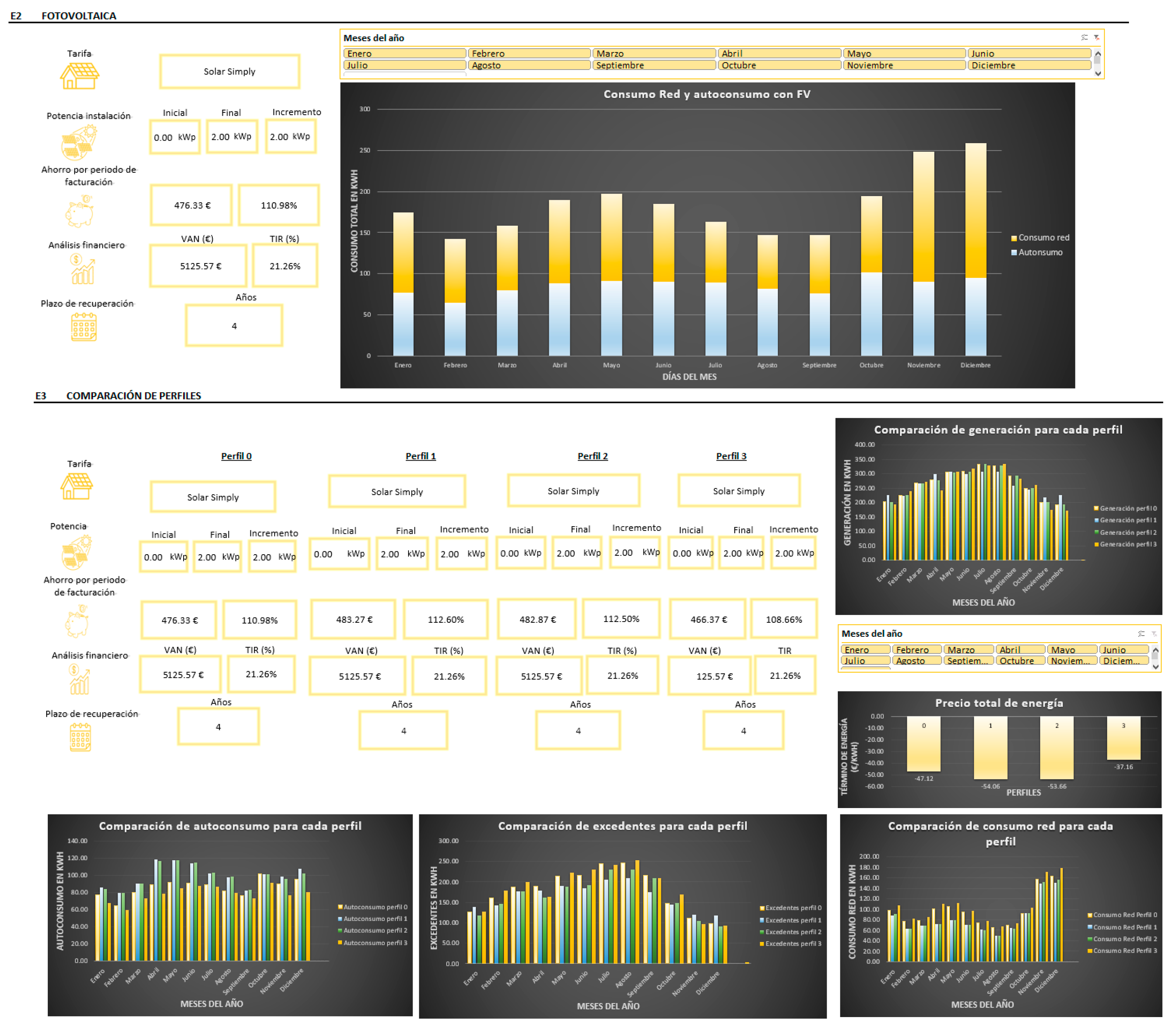
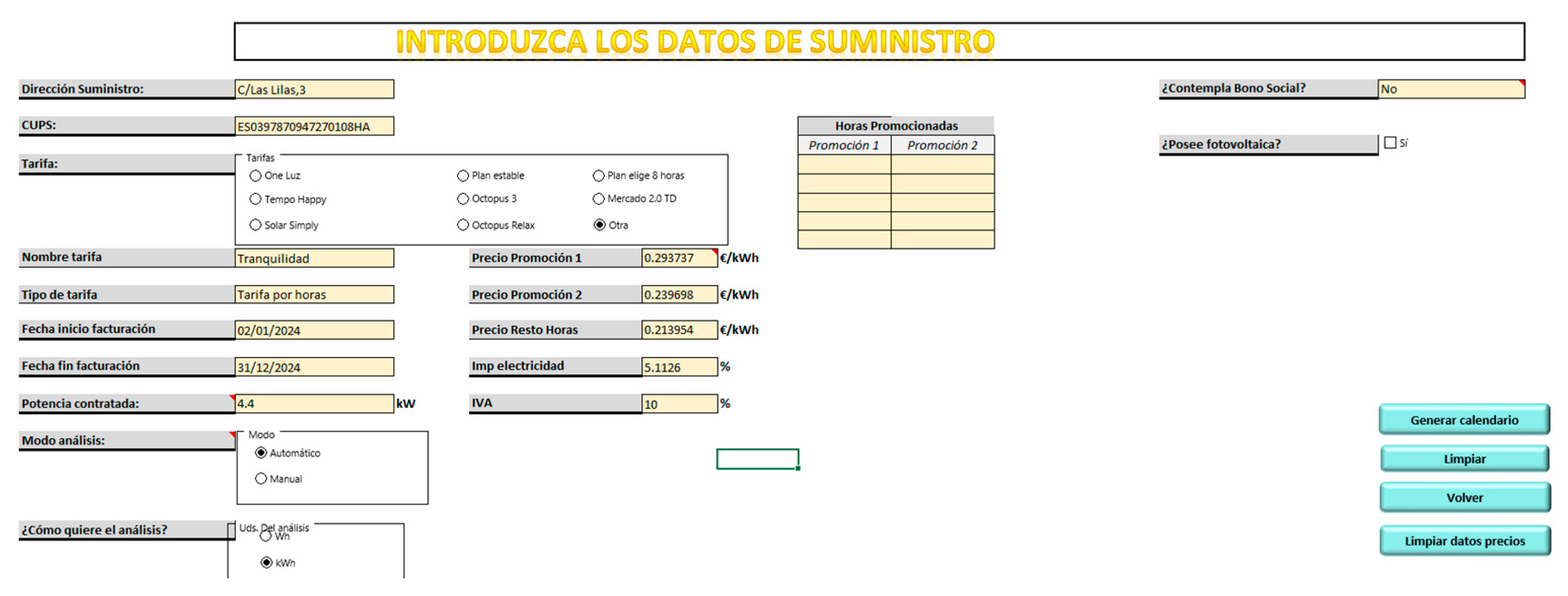
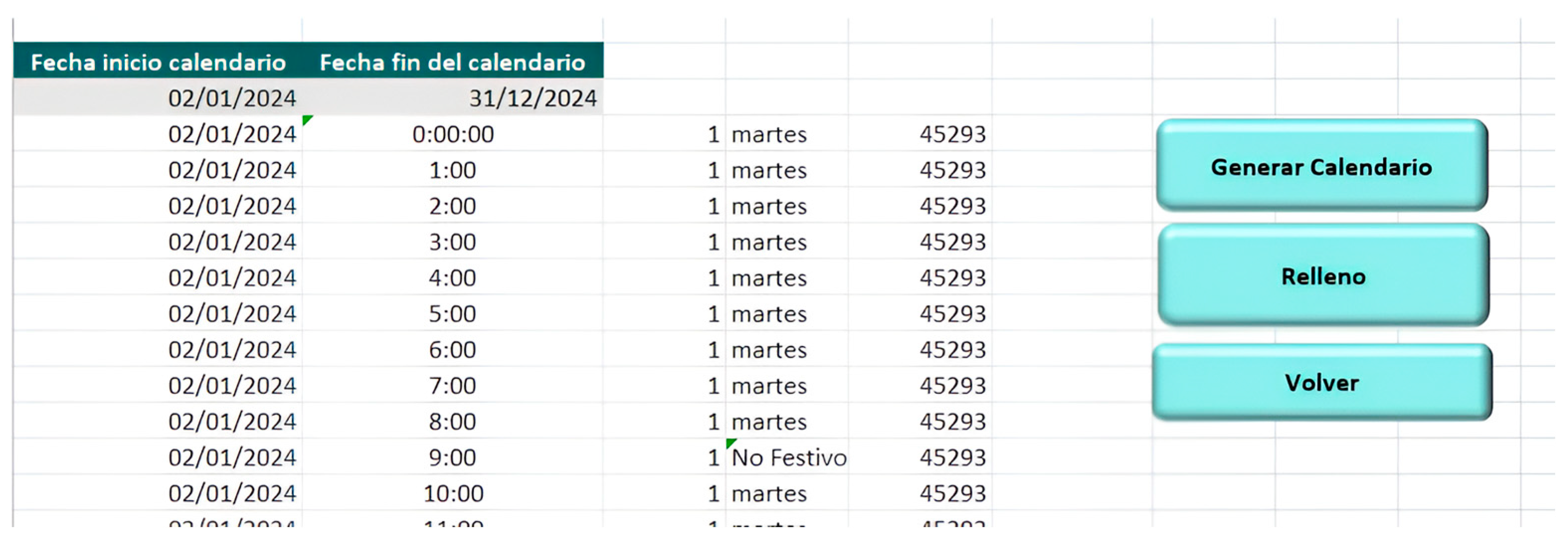
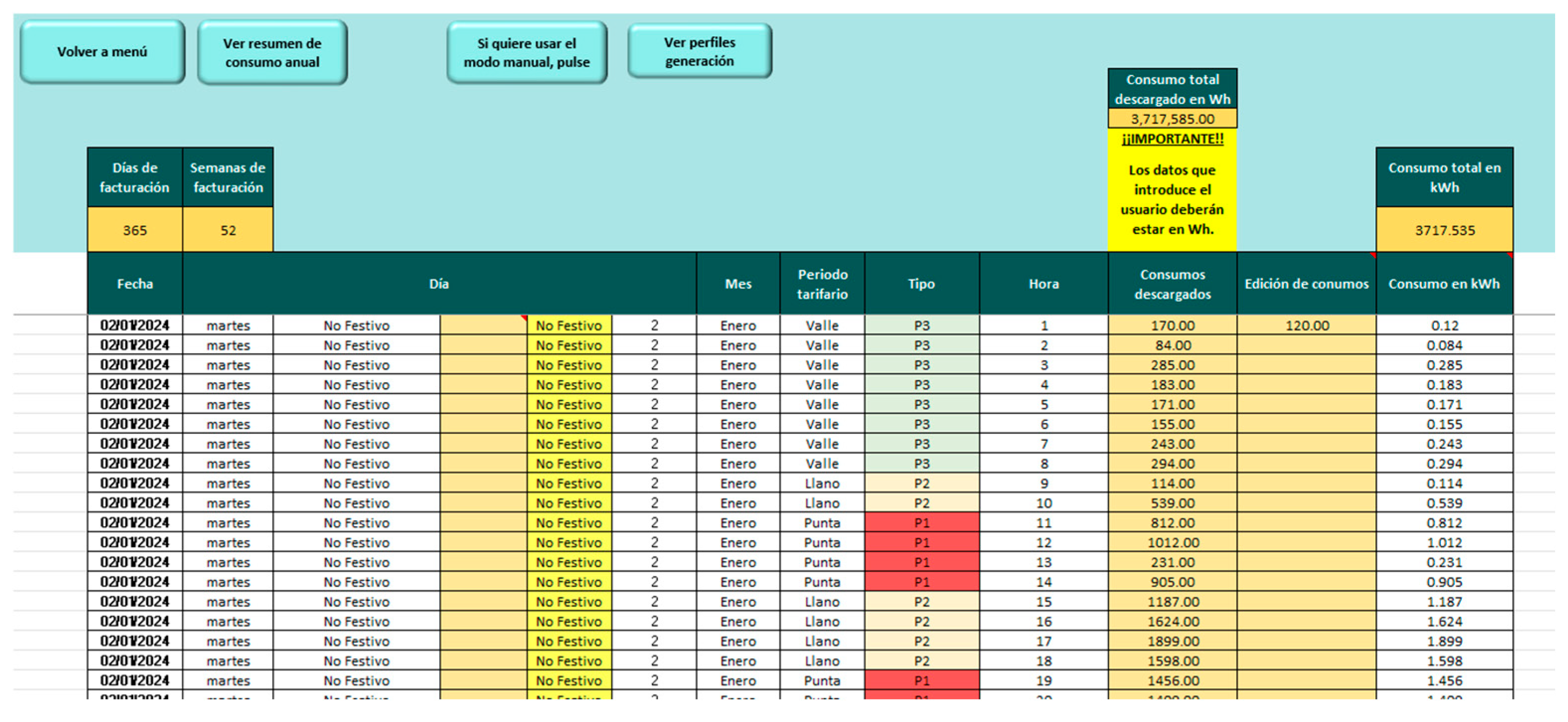
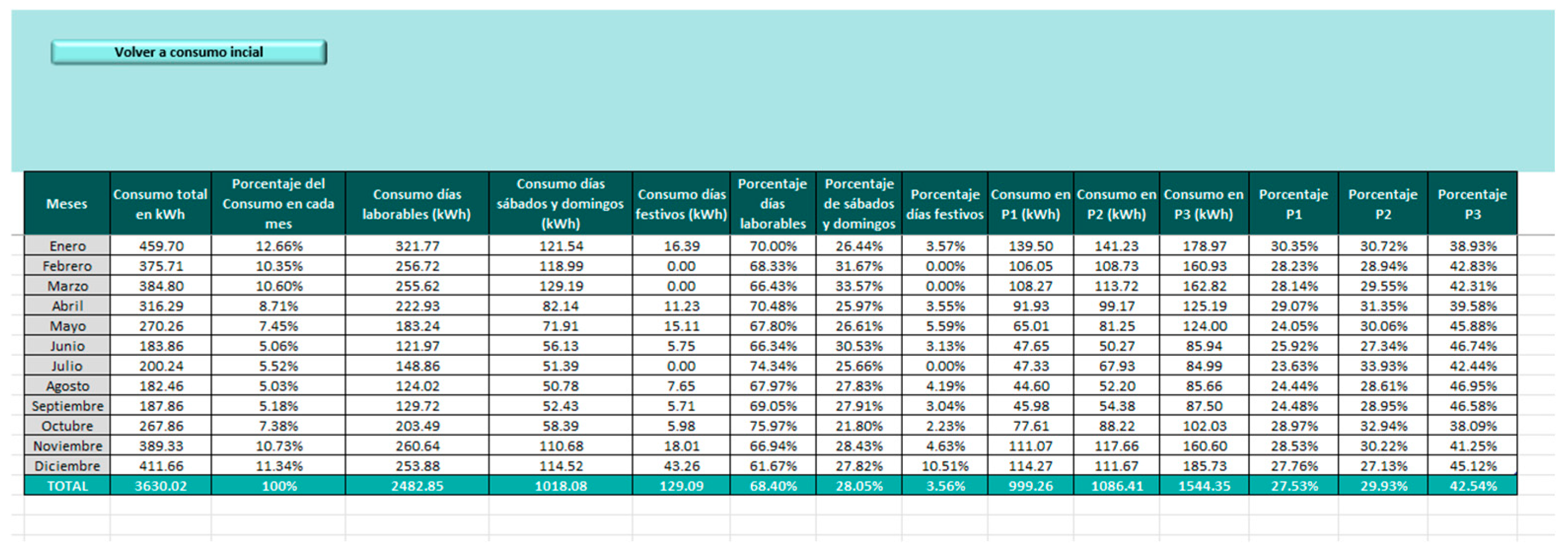
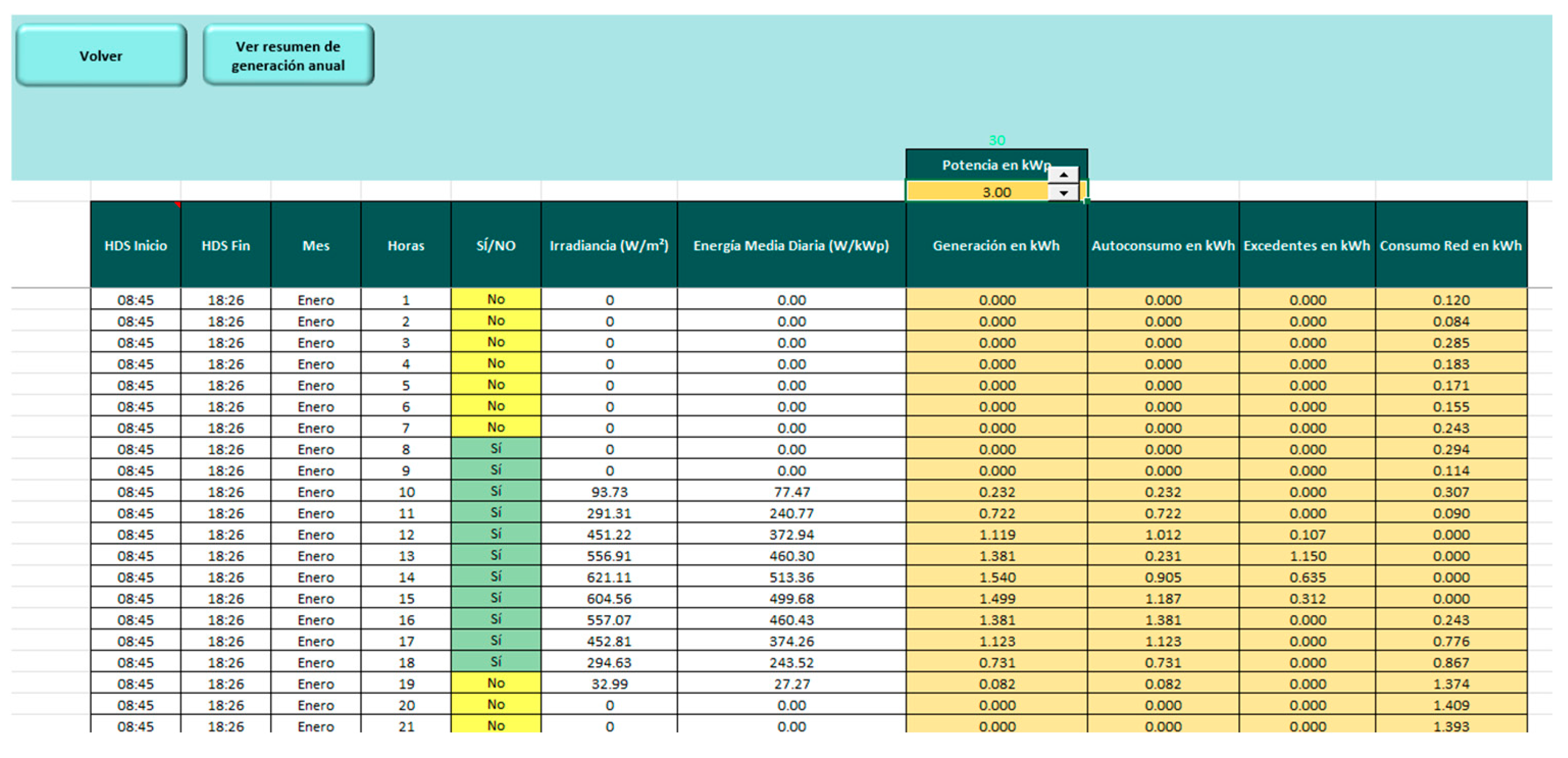



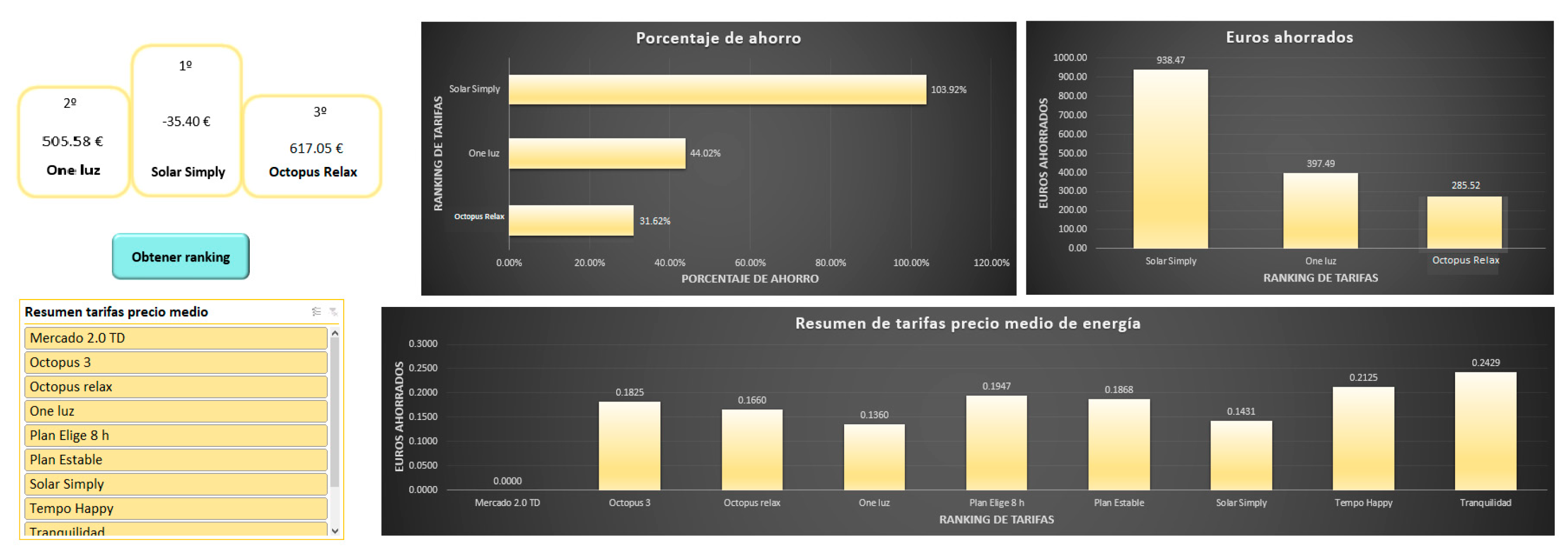
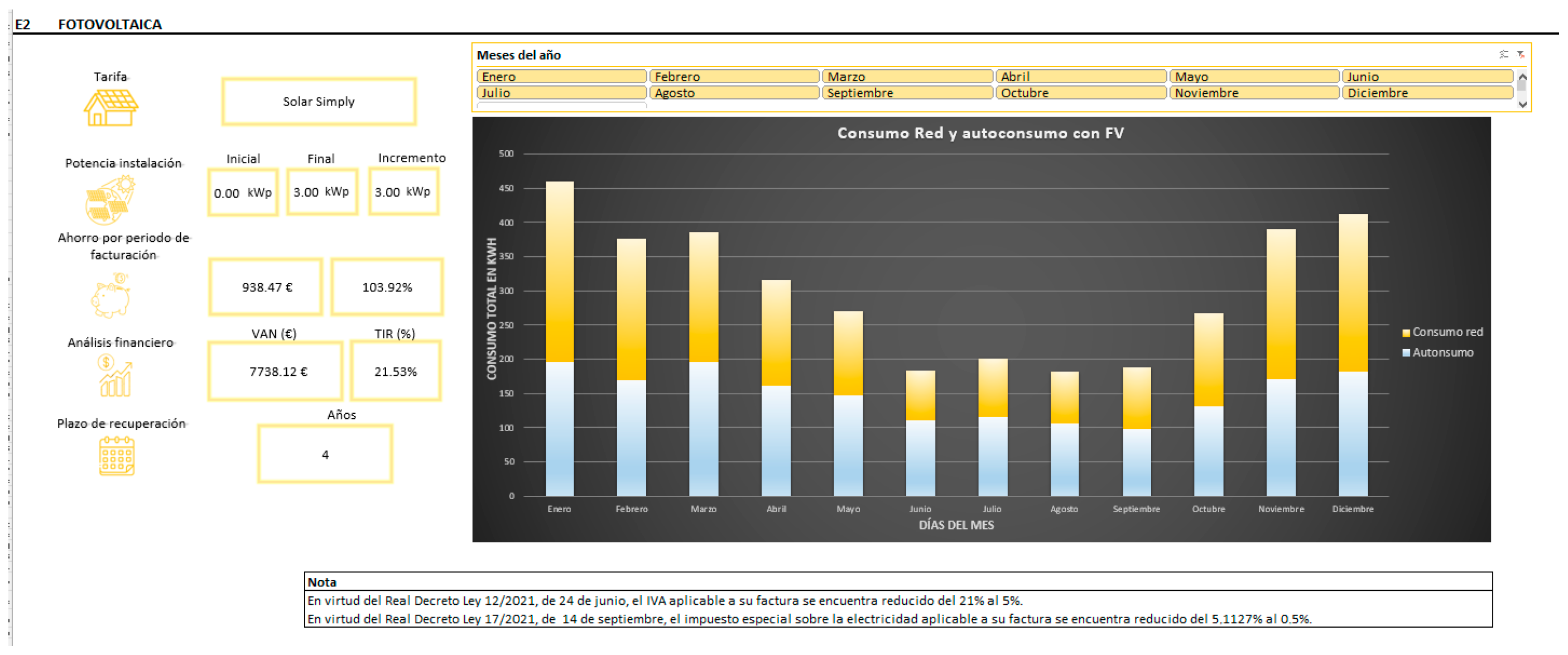
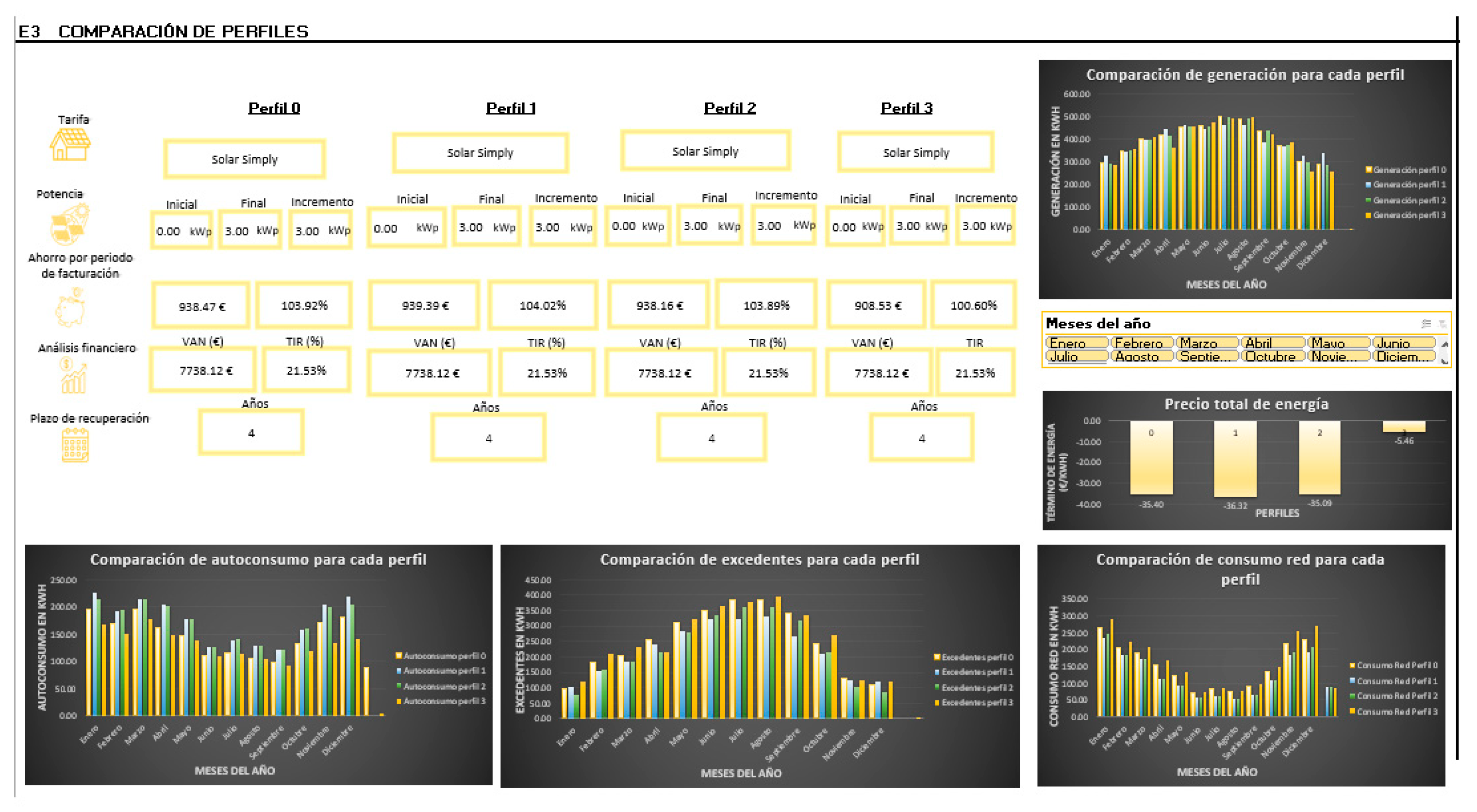
Disclaimer/Publisher’s Note: The statements, opinions and data contained in all publications are solely those of the individual author(s) and contributor(s) and not of MDPI and/or the editor(s). MDPI and/or the editor(s) disclaim responsibility for any injury to people or property resulting from any ideas, methods, instructions or products referred to in the content. |
© 2025 by the authors. Licensee MDPI, Basel, Switzerland. This article is an open access article distributed under the terms and conditions of the Creative Commons Attribution (CC BY) license (https://creativecommons.org/licenses/by/4.0/).
Share and Cite
Tena-Pintado, C.; Román-Galeano, V.A.; Dimitrova-Angelova, D.; Carmona-Fernández, D.; González-González, J.F. Innovation in Energy Saving: Application for the Optimization of Consumption and the Integration of Photovoltaic Energy. Appl. Sci. 2025, 15, 3493. https://doi.org/10.3390/app15073493
Tena-Pintado C, Román-Galeano VA, Dimitrova-Angelova D, Carmona-Fernández D, González-González JF. Innovation in Energy Saving: Application for the Optimization of Consumption and the Integration of Photovoltaic Energy. Applied Sciences. 2025; 15(7):3493. https://doi.org/10.3390/app15073493
Chicago/Turabian StyleTena-Pintado, Celia, Vicente A. Román-Galeano, Dorotea Dimitrova-Angelova, Diego Carmona-Fernández, and Juan Félix González-González. 2025. "Innovation in Energy Saving: Application for the Optimization of Consumption and the Integration of Photovoltaic Energy" Applied Sciences 15, no. 7: 3493. https://doi.org/10.3390/app15073493
APA StyleTena-Pintado, C., Román-Galeano, V. A., Dimitrova-Angelova, D., Carmona-Fernández, D., & González-González, J. F. (2025). Innovation in Energy Saving: Application for the Optimization of Consumption and the Integration of Photovoltaic Energy. Applied Sciences, 15(7), 3493. https://doi.org/10.3390/app15073493







